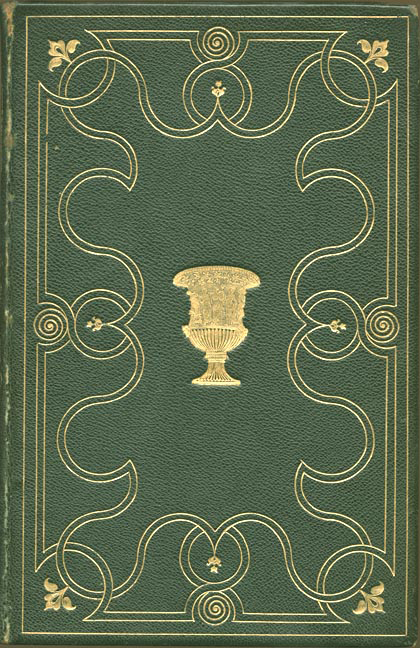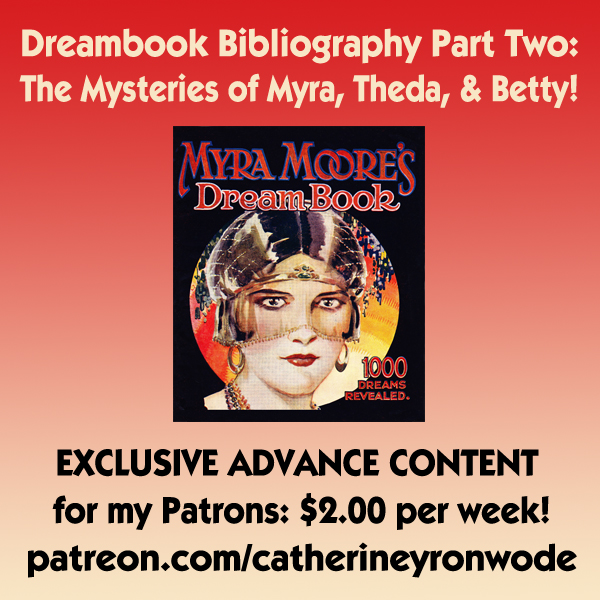Myra Moore [Pseudonym] "Myra Moore's Dream Book 1000 Dreams Revealed Presented with Red Letter."
D.C. Thomson & Co., Ltd., Dundee, Scotland, UK. No date, but
distributed on a February 8th, probably 1921 (see below). 28 pages
(24 pages with coloured paper wraps, but the interior is numbered 3 through 26).
"Red Letter" was a weekly women's story paper that ran from 1899 to 1987. It consisted of a
mix of short fiction, serialized novels, true stories, humour, factual articles, columns,
and vignettes, mostly uncredited or attributed to pseudonyms and publisher's "house
names." The pagination ran continuously through each entire one-year volume. The price of
the paper was originally one penny per copy for 28 pages per week, increasing slowly
through the years until it reached 6 pence for 32 pages in the 1960s. Various 28 page
supplements, such as this dream book and in-depth presentations on non-fiction topics
considered of general interest to women, were issued regularly at no extra cost to the
subscribers.
The unsigned cover features a watercolour painting of a mysterious dark-haired and veiled
woman wearing a jewelled metal circlet, gold hoop earrings, and several strands of what
appear to be green and brown cat's eye shell or glass anti-evil-eye beads. She stares
fixedly, almost hypnotically, at the viewer.
Cover 2 presents an unusual exegesis on the
general meaning of dreams according to the days of the week. Page 1 (which is numbered
page 3) through page 19 (numbered page 21) consist of dream meanings, without lucky
numbers. There are nice block headings for each letter of the alphabet containing the
letter as a large capital accompanied by a small line-art drawing in the style of a children's
alphabet book, illustrating the first word for the letter. Being a Scottish dream book, it
comes as no surprise that the letter H is represented by Haggis and the illustration
depicts a man dressed in a tartan kilt presenting the Scottish national dish to a group of
seated Englishmen in formal back suits who are seated at a dinner table.
Pages 20 (numbered page 22) through half of cover 4 present "Your Birthday Dream." This is
a list of all 366 days in the year (February 29th is included, for those born on that day)
and what steps you should take to ensure having "the happiest dream possible" to wake up
from on your personal anniversary. The prescriptions or magical spells are pretty wild:
"Wear all night a key tied round your neck with a green ribbon," or "Wear a stocking with
three holes in it on your right foot." Someone took a lot of time and had a lot of fun
creating these bits of "instant folklore." Also on cover 4 is a half-page advertisement
for the next week's issue of "Red Letter," which will contain a free gift booklet titled
"Dorothy's Book of Etiquette."
Dating this dream book took some research. I went into it knowing only one thing: the
paper stock, art style, typesetting, and content pointed to a date before 1925.
First, regarding the name "Myra Moore," i found no documentation of a person with that
name working as a fortune teller, crystal gazer, card reader, dream interpreter,
numerologists, or occultist in England or Scotland during the early 20th century and i
assumed the name to be a fabrication.
However, given the time period, the name Myra may have come from "The Mysteries of Myra,"
a huge hit silent film serial about the occult and the supernatural that was released in
15 cliff-hanger cinema chapters throughout 1916. The movie was also novelized as "The Mysteries
of Myra" by Eustace Hale Ball, from the screenplay by the famed paranormal investigator
Hereward Carrington and the well-known screen-serial author Charles Goddard, and was
issued as a newspaper serialization in 1916 to coincide with the ongoing release of the
film chapters.
The star of "The Mysteries of Myra," was Jean Sothern (1893-1964), and her naturally
blonde appearance could best be described as "naive and distressed," as if Mary Pickford
or Lillian Gish was suddenly plunged into the Dark Dimension. The film was actually the
first occult-horror movie ever made, and the convoluted plot followed Myra Maynard, whose
father was an occultist, through a series of "mysteries" that included crystal gazing,
hypnotism, mystic mirrors, occult rituals, dream omens, witchcraft, and voodoo.
Despite the name "Myra," the unsigned artist's beautiful watercolour rendition of the fictitious Myra Moore on the
cover of the dream book shows a dark haired woman who resembles and is clothed similarly
to the great silent film star Theda Bara (1885–1955). Bara was a black-haired Jewish woman
who, from 1914 to 1919, specialized in playing "darkly exotic" Egyptian, Greek, Spanish, French, Russian,
Gypsy, and Vampire types such as Cleopatra, Carmen, Esmerelda, The She-Devil, The Tiger-woman, and Salomé.
She starred in 40 full-length films for Fox studios during this five-year period, all but one of which
were later lost in a warehouse fire where the reels were stored. All we have left of her
large and popular body of work are plot synopses, contemporary reviews, still photos, and a
few behind-the-scenes snapshots.
In 1915 Bara co-starred in "The Two Orphans" with Jean Sothern, the actress who went on to
star in "The Mysteries of Myra" in 1916. The link may be coincidence, but it is worth a smile.
In 1917 Bara starred in "The Tiger Woman" as a Russian femme fatale, and she wore a very complex hat with a tassled veil,
much like the one in the cover painting of "Myra Moore's Dream Book." The veiled hat was the creation of the London-based
international couturier and milliner Lucile (Lucy Duff Gordon), who designed many of Theda Bara's on-screen vamp costumes.
Lucile, by the way, specialized in draped cloth gowns of diaphanous layers with low necklines and slit skirts.
She was the first designer to hire dress models, call them "mannequins,"
and have them parade them down what is now known as a fashion catwalk; the models were instructed to remain silent, lest their
lower-class accents reveal to the elite dress buyers that they were members of the proletariat.
Theda Bara wore this specific veil hat by Lucile in only this one movie, and i am certain that the cover artist was referencing it,
which means that "Myra Moore's Dream Book" has to date from 1917 or later, in order for a publicity still to have been
clipped from a newspaper or magazine and added to his or her swipe file or image morgue.
Because the woman on the "Myra Moore's Dream Book" cover painting is less "Jewish looking" than Theda Bara, she
also somewhat resembles Betty Blythe (1895-1972), an Anglo-Saxon Theda Bara impersonator.
Blythe's first credited film role was released in 1917. Her natural hair colour was medium blonde, but in 1921 she
wore a black wig when she was selected to play the "darkly exotic" title role in "Queen
of Sheba."
"Queen of Sheba" was originally written as a starring vehicle for the naturally "exotic" Theda
Bara, but Bara quit (or was pushed out of) the Fox studio before filming began. Blythe was cast to replace Bara, and
she did so by means of semi-successful mimicry. She did not have Bara's dark features, but she was able to
more-or-less copy Bara's intense physical mannerisms, in a style i would describe as that of
a sexually daring prom queen. She was also clothed in Theda Bara style costumes, like those Lucile had
made famous for Bara.
Blythe-as-Bara must have worked at the box office, because four years later, Blythe was
again made up as a dark-haired vamp, to undertake the equally Bara-esque role of Ayesha in "She" (1925). Bythe did not normally
appear as a Theda Bara look-alike, but in those two films, she definitely was costumed,
made up, and posed for portraits in the manner of Theda Bara.
Based on the name Myra, as well as the Theda Bara and Betty-Blythe-as-Theda-Bara cover
image, i preliminarily dated "Myra Moore's Dream Book" to circa 1916-1925, or from
Sothern's appearance in "The Mysteries of Myra," through Bara's entire early career, to Blythe's Bara
impersonation in "She."
The booklet bears no date of issue, but cover 4 carries a
half-page advertisement for "Another Gift for You Next Week," namely "Dorothy's Book of
Etiquette" to be "Given Free with Red Letter On Sale Tuesday, 15th Feb." Thus we learn
that at this time the weekly "Red Letter" magazine had a Tuesday publication date, and
since February 15th was "next week," that means that "Myra Moore's Dream Book" was
published on February 8th of an unknown year.
Assuming that i got the time period right, February 8th and February 15th fell on Tuesdays
in 1916, 1921, and 1927. "Myra" and Bara were active in 1916, but the cover artist seems to
be copying Bara's tassled veil from "The Tiger Woman" of 1917, Blythe only first impersonated Bara in 1921, and all
three women were out of the publics's eye by 1927, so in the end i chose 1921 as the most likely
year, based also in part on the use in the booklet of a hand-lettered version
of a font called Cooper Black Outline, released in 1919, and the clothing styles on the
women in the interior illustrations and back cover, with their slim skirts; sleeveless tops, bulky hats;
flat chests; and spit curls.
One last note: Myra Moore is actually a fairly common name, and, strangely, its connection
to occultism and witchery continues, for even today, more than 100 years after "The
Mysteries of Myra" and "Myra Moore's Dream Book," there is a dark-haired ghost hunter with
5 million followers on the internet who goes by the name "Myra Moore, the Paranormal Chic."
|
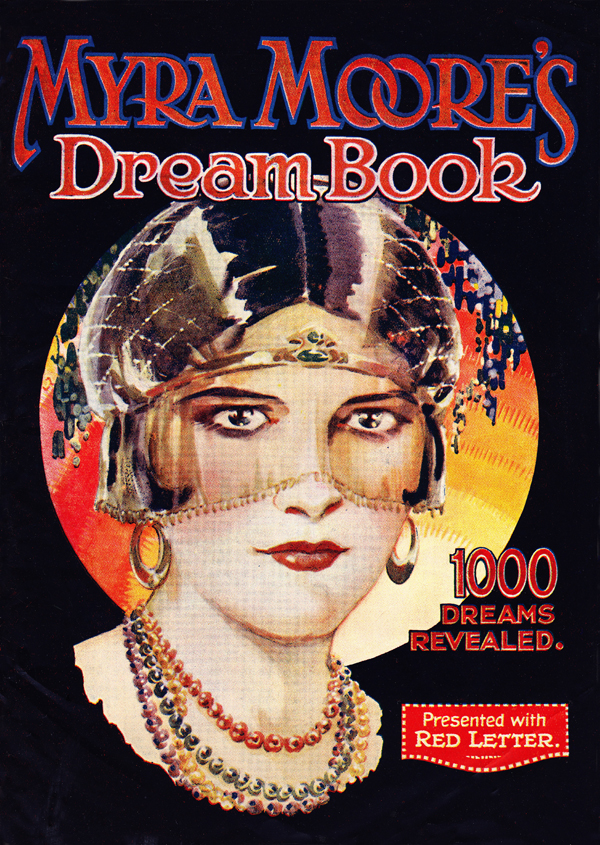 "Myra Moore's Dream Book" given free with "Red Letter" magazine; unknown artist
"Myra Moore's Dream Book" given free with "Red Letter" magazine; unknown artist
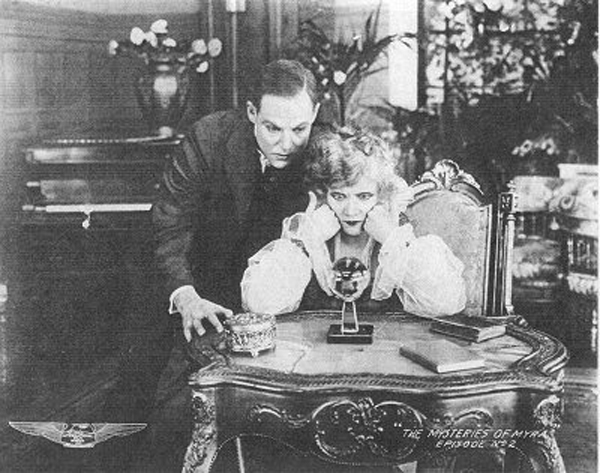
Jean Sothern and Howard Estabrook in a publicity still for "The Mysteries of Myra," a film from 1916.
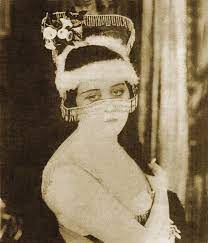
Theda Bara in "The Tiger Woman," a film from 1917; in this publicity still she wears the tasseled veil referenced by
the artist of "Myra Moore's Dream Book" in an elaborate hat created by the fashion designer and
milliner Lucy Duff Gordon, who was professionally known as Lucile.
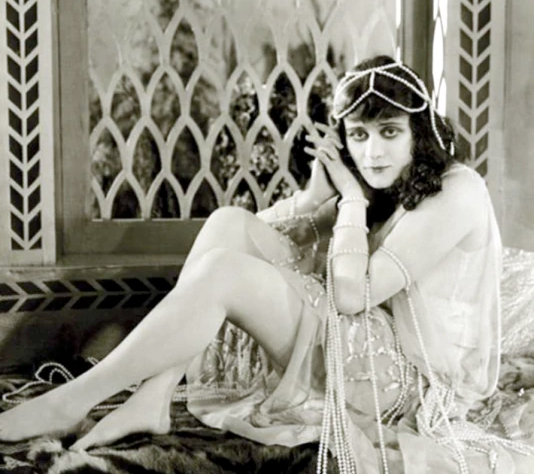
Theda Bara wearing a headpiece of pearls in a publicity still for the 1918 film "Salomé."
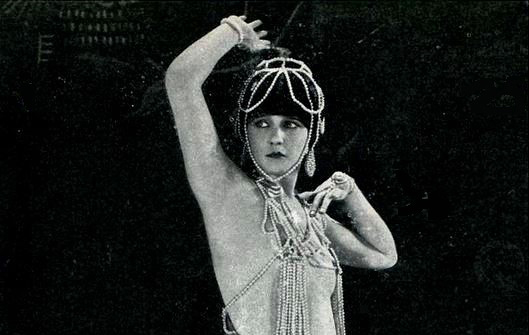
Betty Blythe impersonating Theda Bara in a publicity still for the 1921 film "Queen of Sheba," complete with pearl headpiece.
|
